PONTIAC FIERO 1988 Service Repair Manual
Manufacturer: PONTIAC, Model Year: 1988, Model line: FIERO, Model: PONTIAC FIERO 1988Pages: 1825, PDF Size: 99.44 MB
Page 441 of 1825
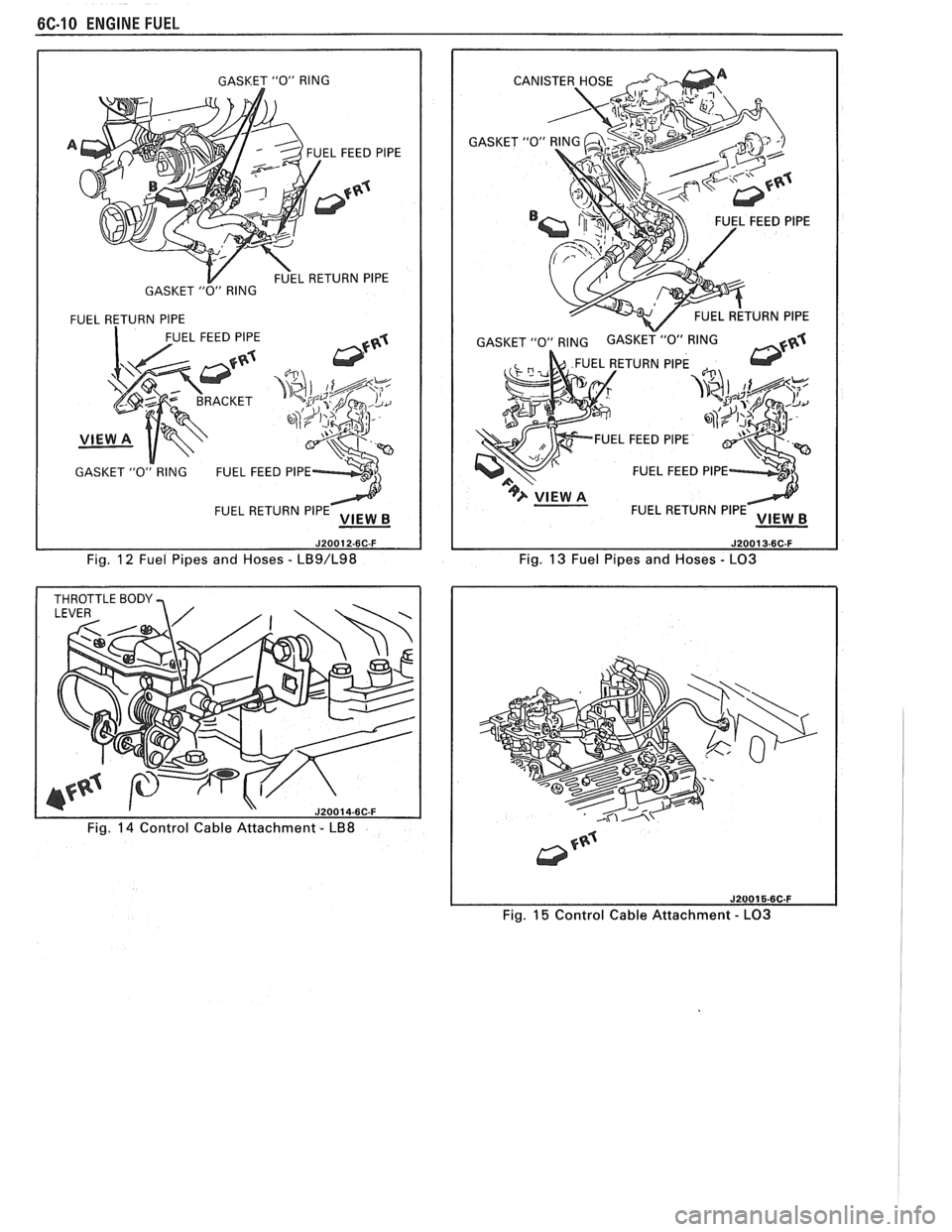
6C-1Q ENGINE FUEL
GASKET "0" RING I
A EL FEED PlPE
L RETURN PlPE
GASKET
"0" RlNG
FUEL RETURN
PIPE I
UEL FEED PlPE
GASKET
"0" RlNG FUEL FEED PIPE
FUEL RETURN PlPE
Fig. 12 Fuel Pipes and Hoses - LB9/L98
I THROTTLE BODY 9 I
Fig. 14 Control Cable Attachment - LB8
GASKET "0" RING GASKET "0" RING
FUEL FEED PlPE
FUEL FEED PlPE
FUEL RETURN PlPE
Fig. 13 Fuel Pipes and Hoses - LO3
Fig. 15 Control Cable Attachment - LO3
Page 442 of 1825
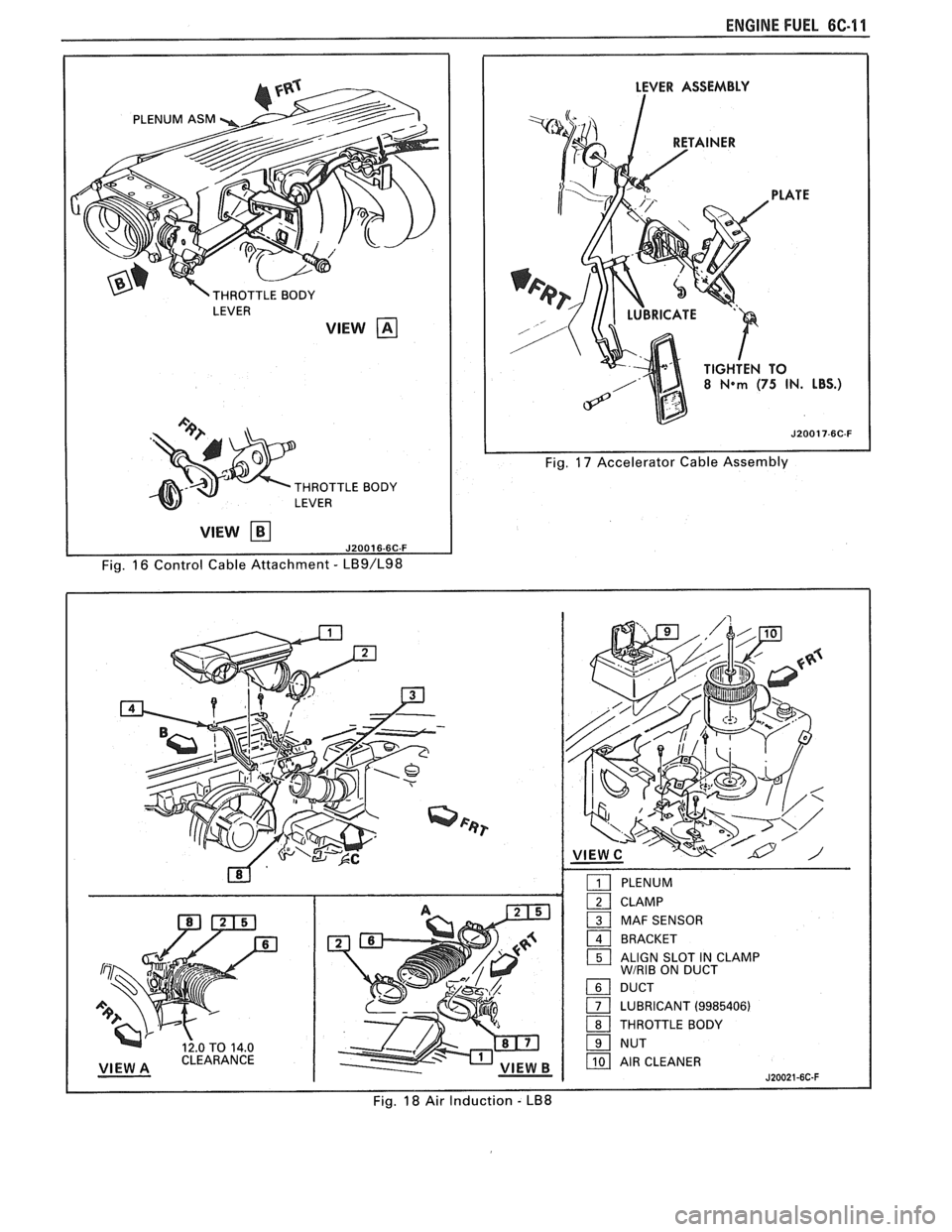
ENGINE FUEL 6C-11
LEVER
VlEW
THROTTLE BODY
LEVER
VlEW kl
Fig. 16 Control Cable Attachment - LB9/L98
LEVER ASSEMBLY
Fig. 17 Accelerator Cable Assembly
Fig.
18 Air Induction - LB8
Page 443 of 1825
![PONTIAC FIERO 1988 Service Repair Manual
6C-12 ENGINE FUEL
VIEW A
MAF SENSOR &
:~~~T
I3] DUCT
1 AIR CLEANER
1 ALIGN SLOT IN CLAMP WIRIB ON DUCT
LUBRICANT
(9985406)
1 THROTTLE BODY
Fig. 19 Air lnduction - LB9/L98
Fig. 20 Air PONTIAC FIERO 1988 Service Repair Manual
6C-12 ENGINE FUEL
VIEW A
MAF SENSOR &
:~~~T
I3] DUCT
1 AIR CLEANER
1 ALIGN SLOT IN CLAMP WIRIB ON DUCT
LUBRICANT
(9985406)
1 THROTTLE BODY
Fig. 19 Air lnduction - LB9/L98
Fig. 20 Air](/img/50/57415/w960_57415-442.png)
6C-12 ENGINE FUEL
VIEW A
MAF SENSOR &
:~~~T
I3] DUCT
1 AIR CLEANER
1 ALIGN SLOT IN CLAMP WIRIB ON DUCT
LUBRICANT
(9985406)
1 THROTTLE BODY
Fig. 19 Air lnduction - LB9/L98
Fig. 20 Air Induction - LO3
Page 444 of 1825
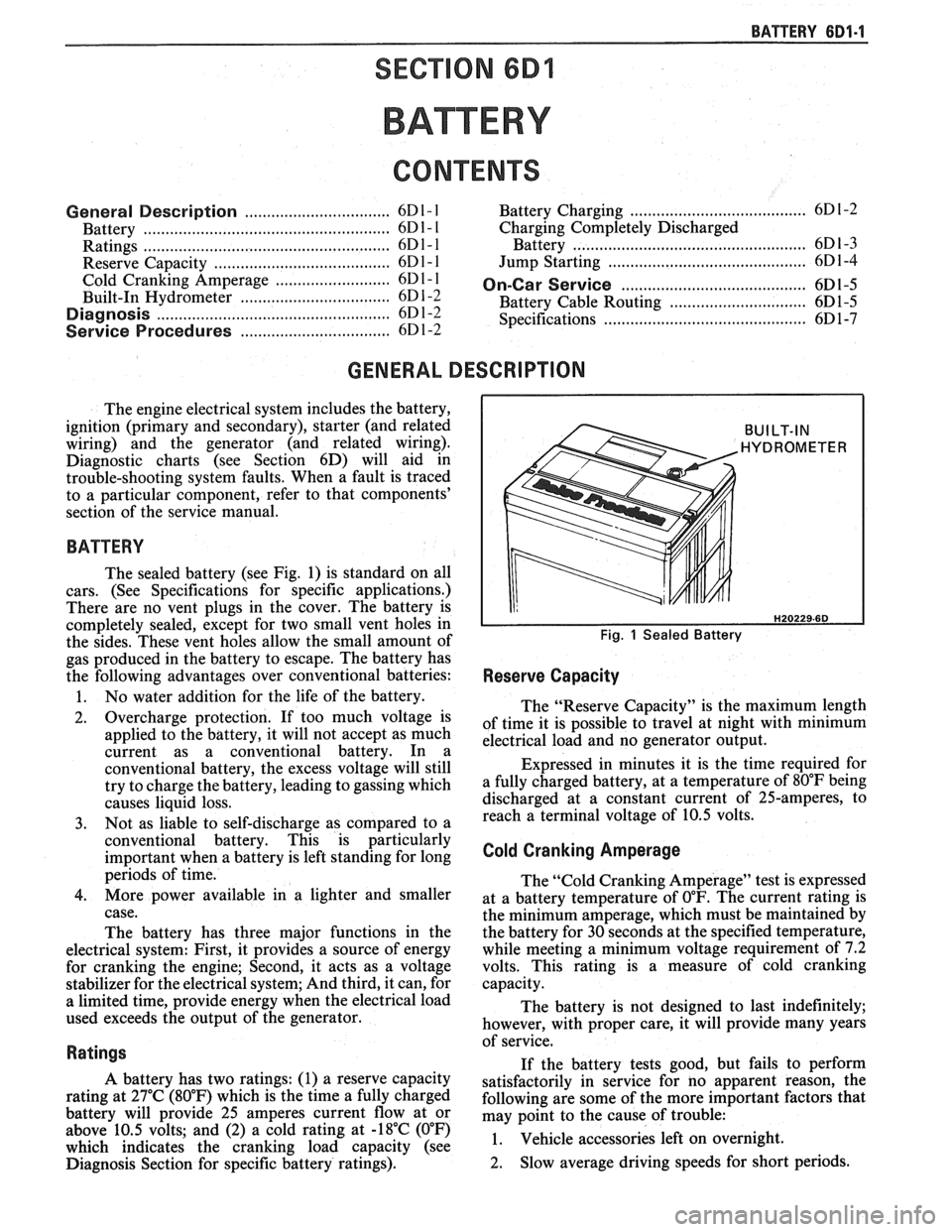
BATTERY 6D1.1
SECTION 6Dl
BATTERY
CONTENTS
.......................... .. General Description ................................ 6D1- 1 Battery Charging ...... 6D 1-2
Battery .......................... ... ....................... 6D 1 - 1 Charging Completely Discharged
.................................................... ............................. Ratings .................... ... 6D 1 - 1 Battery 6D 1-3
........................................... Reserve Capacity ..................................... 6D 1 - 1 Jump Starting 6D
1-4
Cranking ............a*............ 6D1-1 On-Gar Service ...................................... 6Dl-5 .................................. Built-In Hydrometer 6D 1-2 Battery Cable Routing ............................... 6D 1-5 Diagnosis ................................................... 6Dl-2
Specifications .............................................. 6D 1-7 ............................. Service Procedures ..... 6D 1-2
GENERAL DESCRIPTION
The engine electrical system includes the battery,
ignition (primary and secondary), starter (and related
wiring) and the generator (and related wiring).
Diagnostic charts (see Section 6D) will aid in
trouble-shooting system faults. When a fault is traced
to a particular component, refer to that components'
section of the service manual.
BATTERY
The sealed battery (see Fig. 1) is standard on all
cars. (See Specifications for specific applications.)
There are no vent plugs in the cover. The battery is
completely sealed, except for two small vent holes in
the sides. These vent holes allow the small amount of
gas produced in the battery to escape. The battery has
the following advantages over conventional batteries:
1. No water addition for the life of the battery.
2. Overcharge protection. If too much voltage is
applied to the battery, it will not accept as much
current as a conventional battery. In a
conventional battery, the excess voltage will still
try to charge the battery, leading to gassing which
causes liquid loss.
3. Not as liable to self-discharge as compared to a
conventional battery. This is particularly
important when a battery is left standing for long
periods of time.
4. More power available in a lighter and smaller
case.
The battery has three major functions in the
electrical system: First, it provides a source of energy
for cranking the engine; Second, it acts as a voltage
stabilizer for the electrical system; And third, it can, for
a limited time, provide energy when the electrical load
used exceeds the output of the generator.
Ratings
A battery has two ratings: (1) a reserve capacity
rating at 27°C (80°F) which is the time a fully charged
battery will provide 25 amperes current flow at or
above 10.5 volts; and (2) a cold rating at -18°C (0°F)
which indicates the cranking load capacity (see
Diagnosis Section for specific battery ratings).
BUILT-IN
HYDROMETER
Fig. 1 Sealed Battery
Reserve Capacity
The "Reserve Capacity" is the maximum length
of time it is possible to travel at night with minimum
electrical load and no generator output.
Expressed in minutes it is the time required for
a fully charged battery, at a temperature of 80°F being
discharged at a constant current of 25-amperes, to
reach a terminal voltage of 10.5 volts.
Cold Cranking Amperage
The "Cold Cranking Amperage" test is expressed
at a battery temperature of
0°F. The current rating is
the minimum amperage, which must be maintained by
the battery for 30 seconds at the specified temperature,
while meeting a minimum voltage requirement of 7.2
volts. This rating is a measure of cold cranking
capacity.
The battery is not designed to last indefinitely;
however, with proper care, it will provide many years
of service.
If the battery tests good, but fails to perform
satisfactorily in service for no apparent reason, the
following are some of the more important factors that
may point to the cause of trouble:
1. Vehicle
accessories left on overnight.
2. Slow
average driving speeds for short periods.
Page 445 of 1825
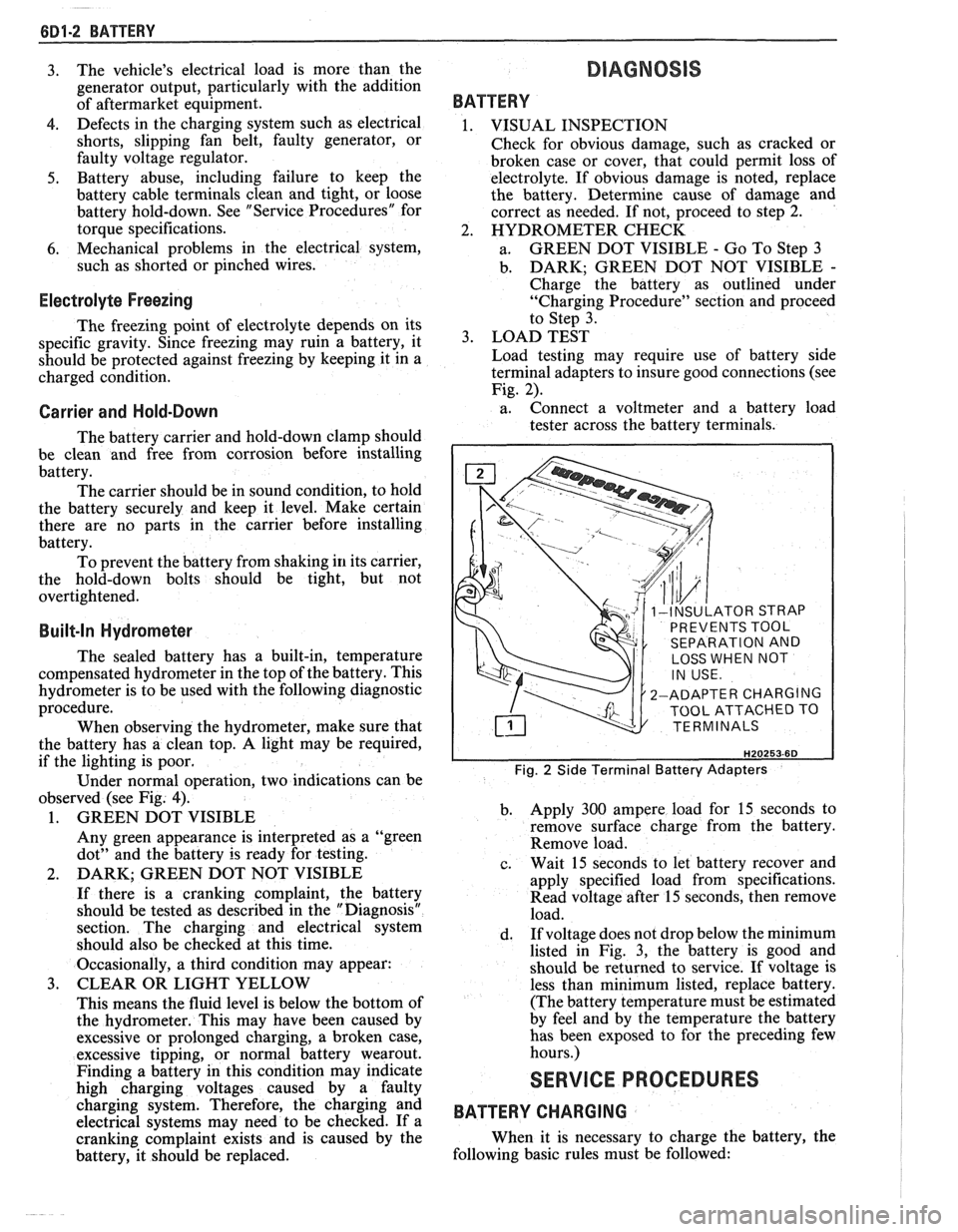
6D1-2 BA'TTERY
3. The
vehicle's electrical load is more than the
generator output, particularly with the addition
of aftermarket equipment.
4. Defects in the charging system such as electrical
shorts, slipping fan belt, faulty generator, or
faulty voltage regulator.
5. Battery abuse, including failure to keep the
battery cable terminals clean and tight, or loose
battery hold-down. See "Service Procedures" for
torque specifications.
6. Mechanical problems in the electrical system,
such as shorted or pinched wires.
Electrolyte Freezing
The freezing point of electrolyte depends on its
specific gravity. Since freezing may ruin a battery, it
should be protected against freezing by keeping it in a
charged condition.
Carrier and Hold-Down
The battery carrier and hold-down clamp should
be clean and free from corrosion before installing
battery.
The carrier should be in sound condition, to hold
the battery securely and keep it level. Make certain
there are no parts in the carrier before installing
battery.
To prevent the battery from shaking
in its carrier,
the hold-down bolts should be tight, but not
overtightened.
Built-In Hydrometer
The sealed battery has a built-in, temperature
compensated hydrometer in the top of the battery. This
hydrometer is to be used with the following diagnostic
procedure.
When observing the hydrometer, make sure that
the battery has a clean top. A light may be required,
if the lighting is poor.
Under normal operation, two indications can be
observed (see Fig.
4).
1. GREEN DOT VISIBLE
Any green appearance is interpreted as a "green
dot" and the battery
is ready for testing.
2. DARK; GREEN DOT NOT VISIBLE
If there is a cranking complaint, the battery
should be tested as described in the "Diagnosis"
section. The charging and electrical system
should also be checked at this time.
Occasionally, a third condition may appear:
3. CLEAR OR LIGHT YELLOW
This means the fluid level is below the bottom of
the hydrometer. This may have been caused by
excessive or prolonged charging, a broken case,
excessive tipping, or normal battery
wearout.
Finding a battery in this condition may indicate
high charging voltages caused by a faulty
charging system. Therefore, the charging and
electrical systems may need to be checked. If a
cranking complaint exists and is caused by the
battery, it should be replaced.
BATTERY
1. VISUAL INSPECTION
Check for obvious damage, such as cracked or
broken case or cover, that could permit loss of
electrolyte. If obvious damage is noted, replace
the battery. Determine cause of damage and
correct as needed. If not, proceed to step 2.
2. HYDROMETER CHECK
a. GREEN
DOT VISIBLE
- Go To Step 3
b. DARK;
GREEN DOT NOT VISIBLE -
Charge the battery as outlined under
"Charging Procedure" section and proceed
to Step 3.
3. LOAD TEST
Load testing may require use of battery side
terminal adapters to insure good connections (see
Fig. 2).
a. Connect
a voltmeter and a battery load
tester across the battery terminals.
INSULATOR STRAP
PREVENTS TOOL
SEPARATION AND
LOSS WHEN NOT
2-ADAPTER CHARGING
TOOL ATTACHED TO
TERMINALS
Fig. 2 Side Terminal Battery Adapters
b. Apply 300 ampere load for 15 seconds
to
remove surface charge from the battery.
Remove load.
c. Wait
15 seconds to let battery recover and
apply specified load from specifications.
Read voltage after 15 seconds, then remove
load.
d. If
voltage does not drop below the minimum
listed in Fig. 3, the battery is good and
should be returned to service. If voltage is
less than minimum listed, replace battery.
(The battery temperature must be estimated
by feel and by the temperature the battery
has been exposed to for the preceding few
hours.)
SERVICE PROCEDURES
BATTERY CHARGING
When it is necessary to charge the battery, the
following basic rules must be followed:
Page 446 of 1825
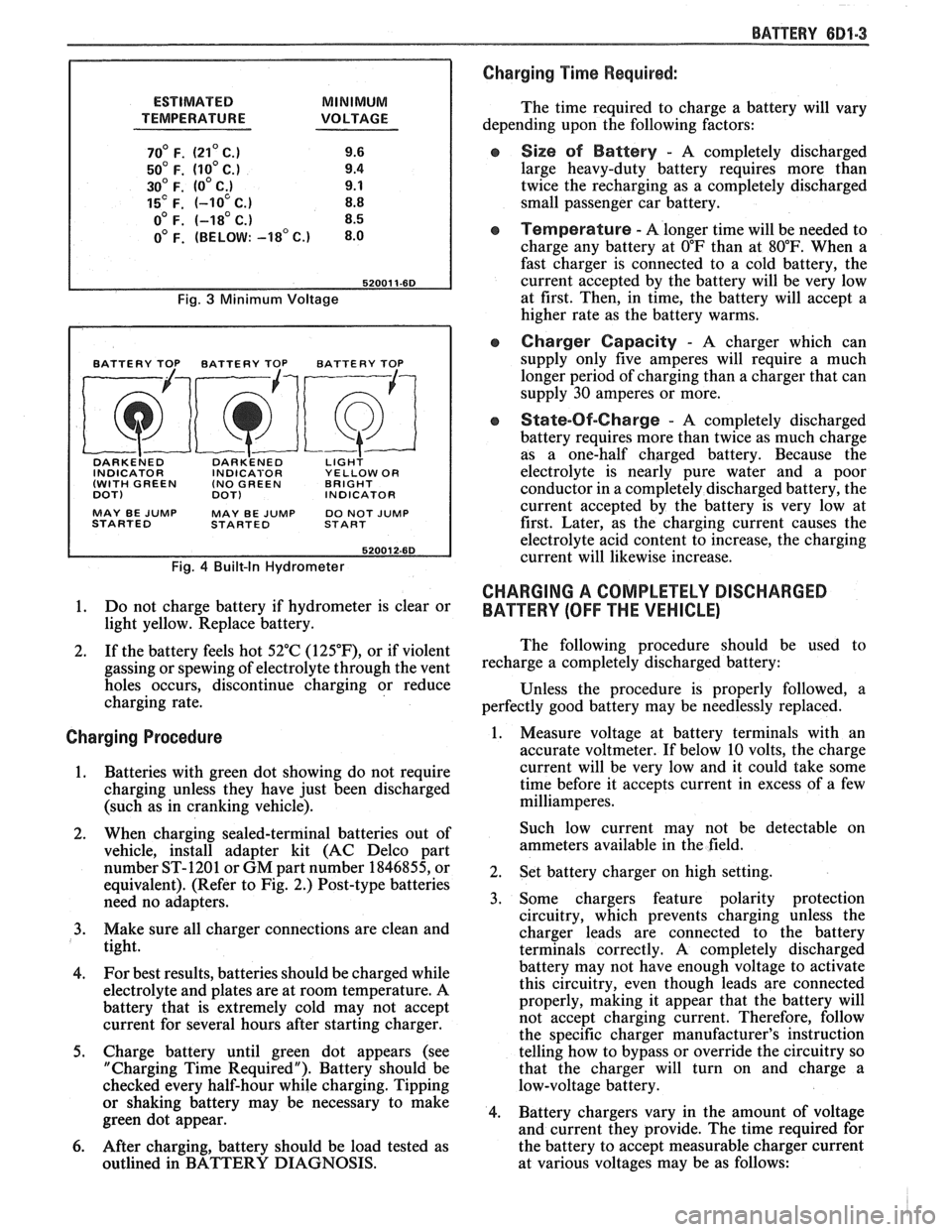
ESTIMATED MINIMUM
TEMPERATURE VOLTAGE
70' F. (21' C.) 9.6
50' F. (10' C.) 9.4
30' F. (0' C;) 9.1
15' F. (-10 C.) 8.8
o0 F. (-18' C.) 8.5
0' F. (BELOW: -18' c.) 8.0
Fig. 3 Minimum Voltage
BATTERY TOP BATTERY TOP BATTERY TOP
DARKE~ED DARK'ENED LIGH? INDICATOR INDICABOR YELLOW OR
(WITH GREEN (NO
GREEN BRIGHT
DOT)
DOT) INDICATOR
MAY BE
JUMP MAY BE JUMP DO NOT JUMP
STARTED STARTED START
Fig. 4 Built-In Hydrometer
1. Do not charge battery if hydrometer is clear or
light yellow. Replace battery.
2. If the battery feels hot 52°C
(125"F), or if violent
gassing or spewing of electrolyte through the vent
holes occurs, discontinue charging or reduce
charging rate.
Charging Procedure
1. Batteries with green
dot showing do not require
charging unless they have just been discharged
(such as in cranking vehicle).
2. When charging sealed-terminal batteries out of
vehicle, install adapter kit (AC Delco part
number ST-1201 or GM part number 1846855, or
equivalent). (Refer to Fig. 2.) Post-type batteries
need no adapters.
3. Make sure all charger connections are clean and
tight.
4. For
best results, batteries should be charged while
electrolyte and plates are at room temperature. A
battery that is extremely cold may not accept
current for several hours after starting charger.
5. Charge battery until green dot appears (see
"Charging Time Required"). Battery should be
checked every half-hour while charging. Tipping
or shaking battery may be necessary to make
green dot appear.
6. After charging, battery should be load tested as
outlined in BATTERY DIAGNOSIS.
BATTERY 681-3
Charging Time Required:
The time required to charge a battery will vary
depending upon the following factors:
e Size sf Battery - A completely discharged
large heavy-duty battery requires more than
twice the recharging as a completely discharged
small passenger car battery.
Temperature - A longer time will be needed to
charge any battery at
O"F than at 80°F. When a
fast charger is connected to a cold battery, the
current accepted by the battery will be very low
at first. Then, in time, the battery will accept a
higher rate as the battery warms.
Charger Capacity - A charger which can
supply only five amperes will require a much
longer period of charging than a charger that can
supply
30 amperes or more.
e State-Of-Charge - A completely discharged
battery requires more than twice as much charge
as a one-half charged battery. Because the
electrolyte is nearly pure water and a poor
conductor in a completely discharged battery, the
current accepted by the battery is very low at
first. Later, as the charging current causes the
electrolyte acid content to increase, the charging
current will likewise increase.
CHARGING A COMPLETELY DISCHARGED
BATTERY
(OFF THE VEHICLE)
The following procedure should be used to
recharge a completely discharged battery:
Unless the procedure is properly followed, a
perfectly good battery may be needlessly replaced.
1. Measure voltage at battery terminals with an
accurate voltmeter. If below 10 volts, the charge
current will be very low and it could take some
time before it accepts current in excess of a few
milliamperes.
Such low current may not be detectable on
ammeters available in the field.
2. Set battery charger on high setting.
3. Some chargers feature polarity protection
circuitry, which prevents charging unless the
charger leads are connected to the battery
terminals correctly. A completely discharged
battery may not have enough voltage to activate
this circuitry, even though leads are connected
properly, making it appear that the battery will
not accept charging current. Therefore, follow
the specific charger manufacturer's instruction
telling how to bypass or override the circuitry so
that the charger will turn on and charge a
low-voltage battery.
4. Battery chargers vary in the amount of voltage
and current they provide. The time required for
the battery to accept measurable charger current
at various voltages may be as follows:
Page 447 of 1825
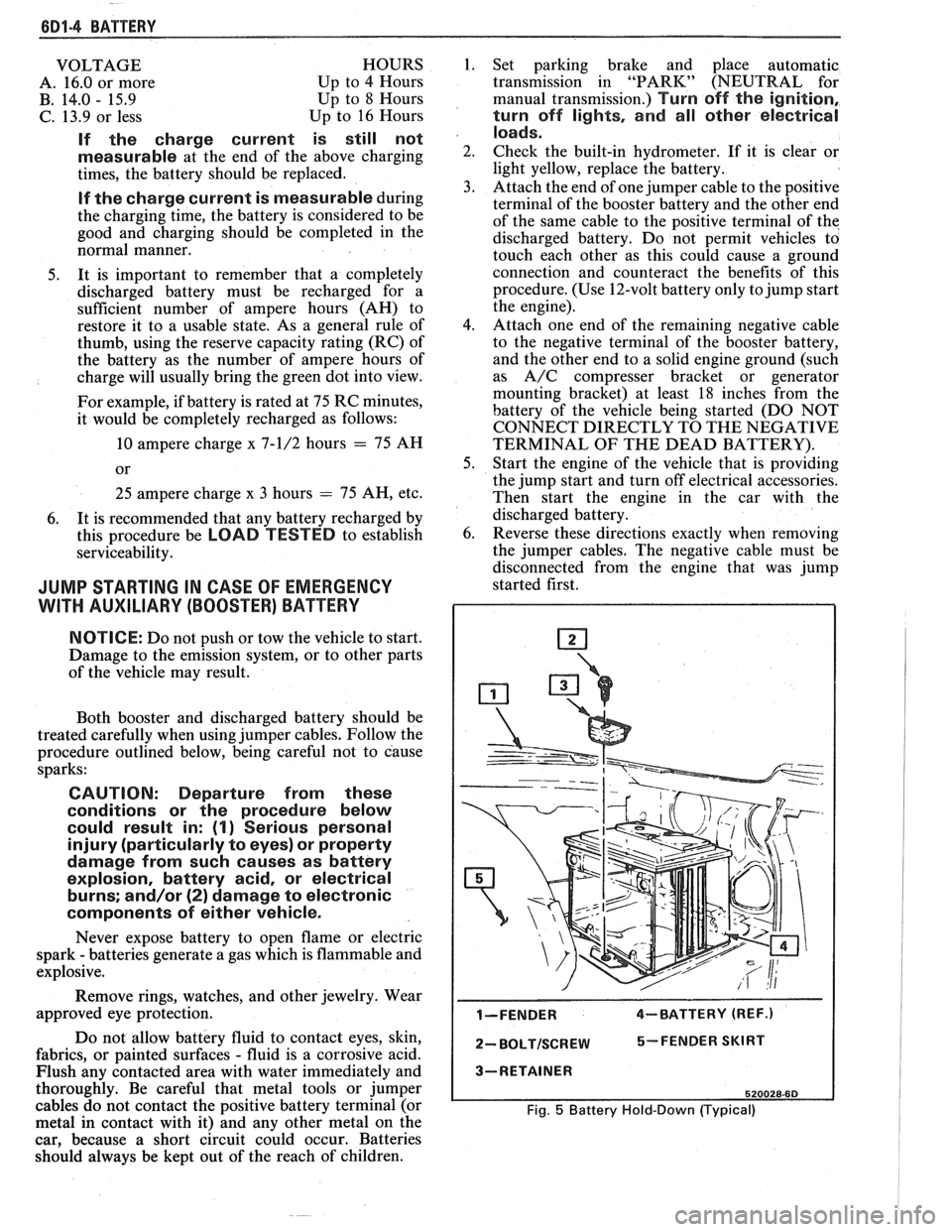
6D1-4 BATTERY
VOLTAGE
A. 16.0 or more
B. 14.0
- 15.9
C. 13.9 or less HOURS
1. Set parking brake and place automatic
Up to 4 Hours transmission in "PARK" (NEUTRAL for
Up to 8 Hours manual transmission.) Turn off the ignition,
Up to 16 Hours turn off lights, and all other electrical
If the charge current is still not
measurable
at the end of the above charging
times, the battery should be replaced.
If the charge current is measurable during
the charging time, the battery is considered to be
good and charging should be completed in the
normal manner.
5. It
is important to remember that a completely
discharged battery must be recharged for a
sufficient number of ampere hours (AH) to
restore it to a usable state. As a general rule of
thumb, using the reserve capacity rating (RC) of
the battery as the number of ampere hours of
charge will usually bring the green dot into view.
For example, if battery is rated at 75 RC minutes,
it would be completely recharged as follows:
10 ampere charge x 7-1/2 hours
= 75 AH
25 ampere charge x 3 hours = 75 AH, etc.
6. It
is recommended that any battery recharged by
this procedure be
LOAD TESTED to establish
serviceability.
JUMP STARTING IN CASE OF EMERGENCY
WITH AUXILIARY (BOOSTER) BAVEEWY
NOTICE: Do not push or tow the vehicle to start.
Damage to the emission system, or to other parts
of the vehicle may result.
Both booster and discharged battery should be
treated carefully when using jumper cables. Follow the
procedure outlined below, being careful not to cause
sparks:
CAUTION: Departure from these
conditions or the procedure below
could result in:
(1) Serious personal
injury (particularly to eyes) or property
damage from such causes as battery
explosion, battery acid, or electrical
burns; and/or
(2) damage to electronic
components of either vehicle.
Never expose battery to open flame or electric
spark
- batteries generate a gas which is flammable and
explosive.
Remove rings, watches, and other jewelry. Wear
approved eye protection.
Do not allow battery fluid to contact eyes, skin,
fabrics, or painted surfaces
- fluid is a corrosive acid.
Flush any contacted area with water immediately and
thoroughly. Be careful that metal tools or jumper
cables do not contact the positive battery terminal (or
metal in contact with it) and any other metal on the
car, because a short circuit could occur. Batteries
should always be kept out of the reach of children.
loads.
2. Check the built-in hydrometer. If it is clear or
light yellow, replace the battery.
3. Attach the end of one jumper cable to the positive
terminal of the booster battery and the other end
of the same cable to the positive terminal of the
discharged battery. Do not permit vehicles to
touch each other as this could cause a ground
connection and counteract the benefits of this
procedure. (Use 12-volt battery only to jump start
the engine).
4. Attach one end of the remaining negative cable
to the negative terminal of the booster battery,
and the other end to a solid engine ground (such
as
A/C compresser bracket or generator
mounting bracket) at least 18 inches from the
battery of the vehicle being started (DO NOT
CONNECT DIRECTLY TO THE NEGATIVE
TERMINAL OF THE DEAD BATTERY).
5. Start the engine of the vehicle that is providing
the jump start and turn off electrical accessories.
Then start the engine in the car with the
discharged battery.
6. Reverse these directions exactly when removing
the jumper cables. The negative cable must be
disconnected from the engine that was jump
started first.
I-FENDER 4-BATTERY (REF.)
2- BOLTISCREW 5-FENDER SKIRT
3-RETAINER
520028-60
Fig. 5 Battery Hold-Down (Typical)
Page 448 of 1825
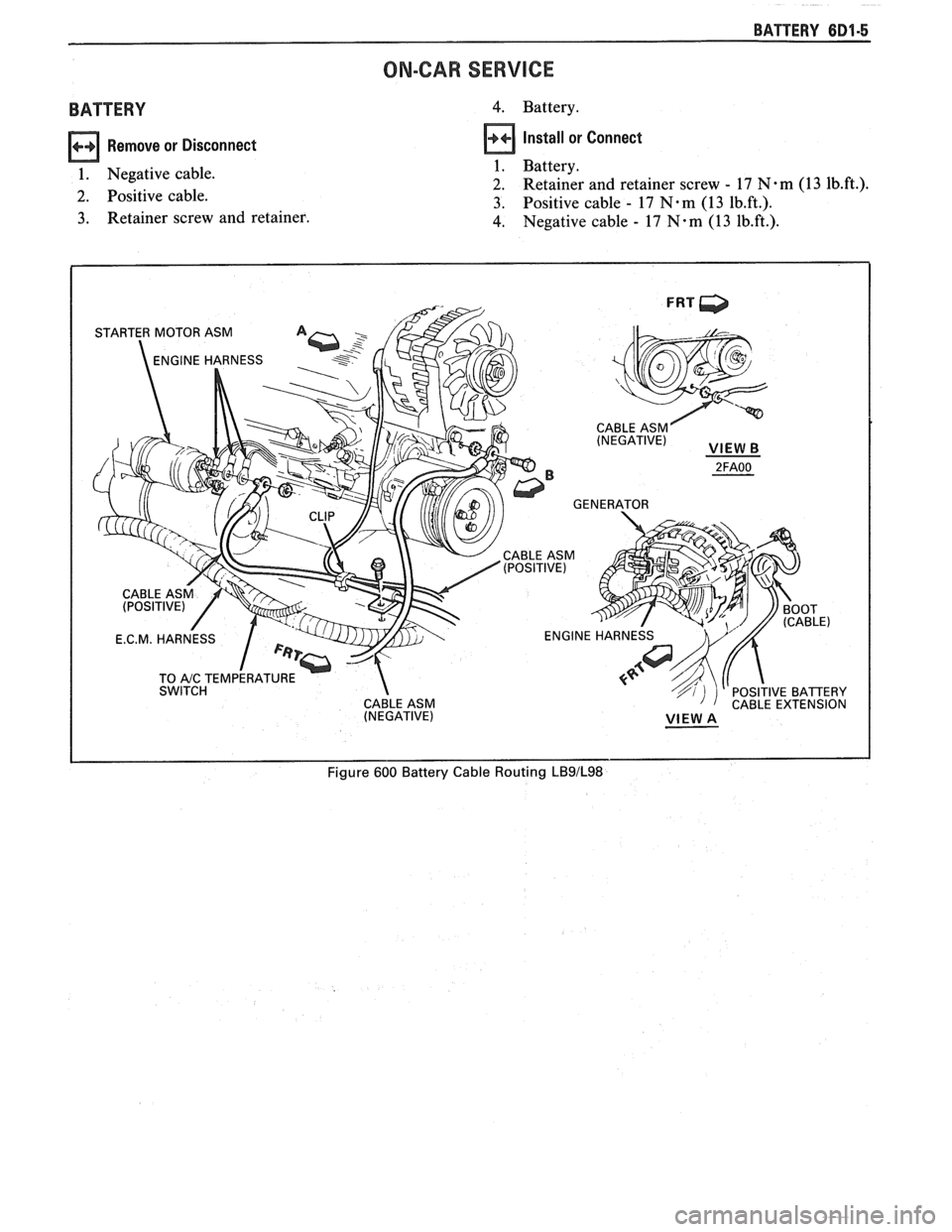
BATTERY 6D1-5
ON-CAR SERVICE
BATTERY
Remove or Disconnect
1. Negative cable.
2. Positive cable.
3. Retainer screw and retainer.
4. Battery.
Install or Connect
1. Battery.
2. Retainer and retainer screw - 17 N.m (13 1b.ft.).
3. Positive cable - 17 N.m (13 1b.ft.).
4. Negative cable - 17 N-m (13 1b.ft.).
Figure 600 Battery Cable Routing LB9lL98
Page 449 of 1825
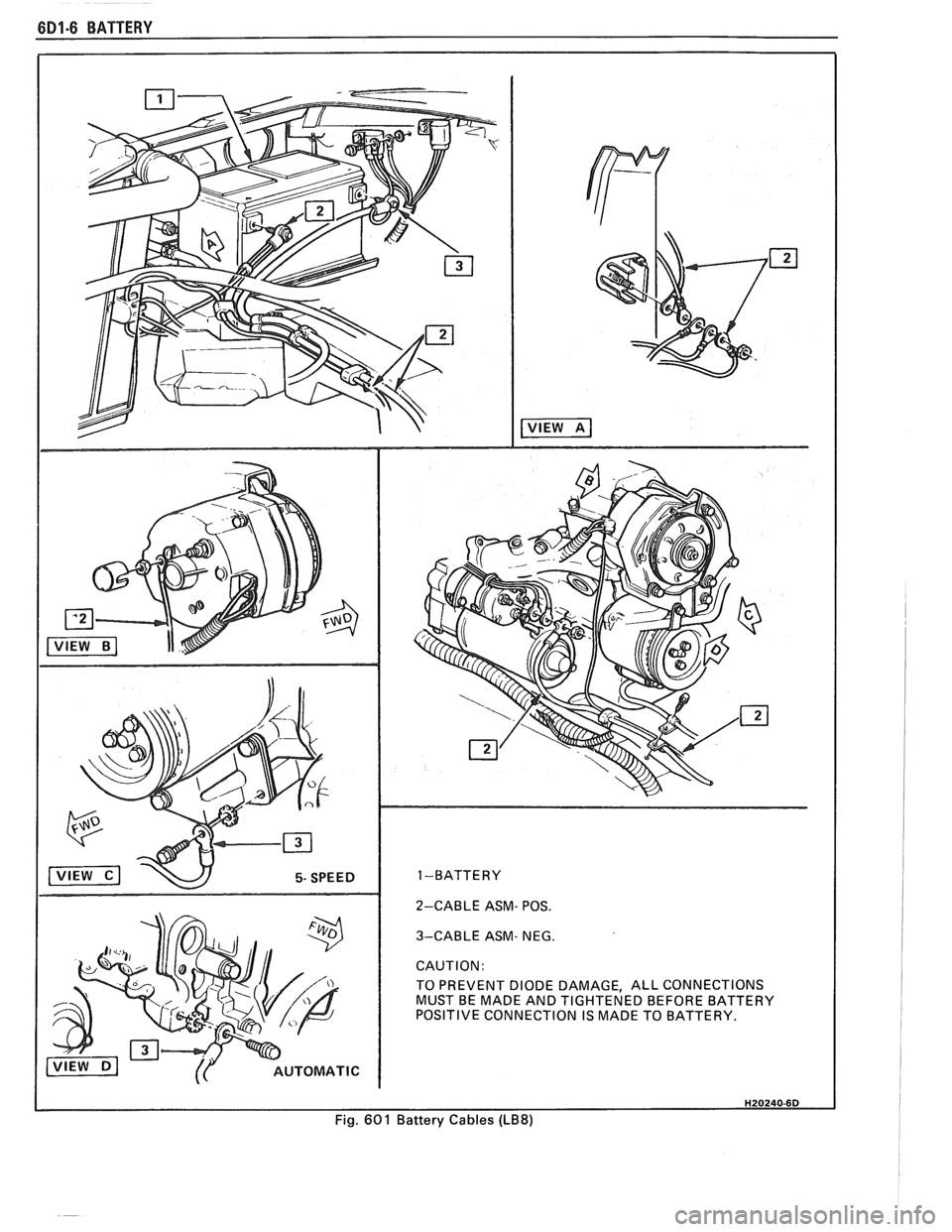
6D1-6 BATTERY
1 -BATTERY
2-CABLE ASM- POS.
3-CABLE ASM- NEG.
TO PREVENT DIODE DAMAGE, ALL CONNECTIONS
MUST BE MADE AND TIGHTENED BEFORE BATTERY
POSITIVE CONNECTION IS MADE TO BATTERY.
Fig.
60 1 Battery Cables (LB8)
Page 450 of 1825
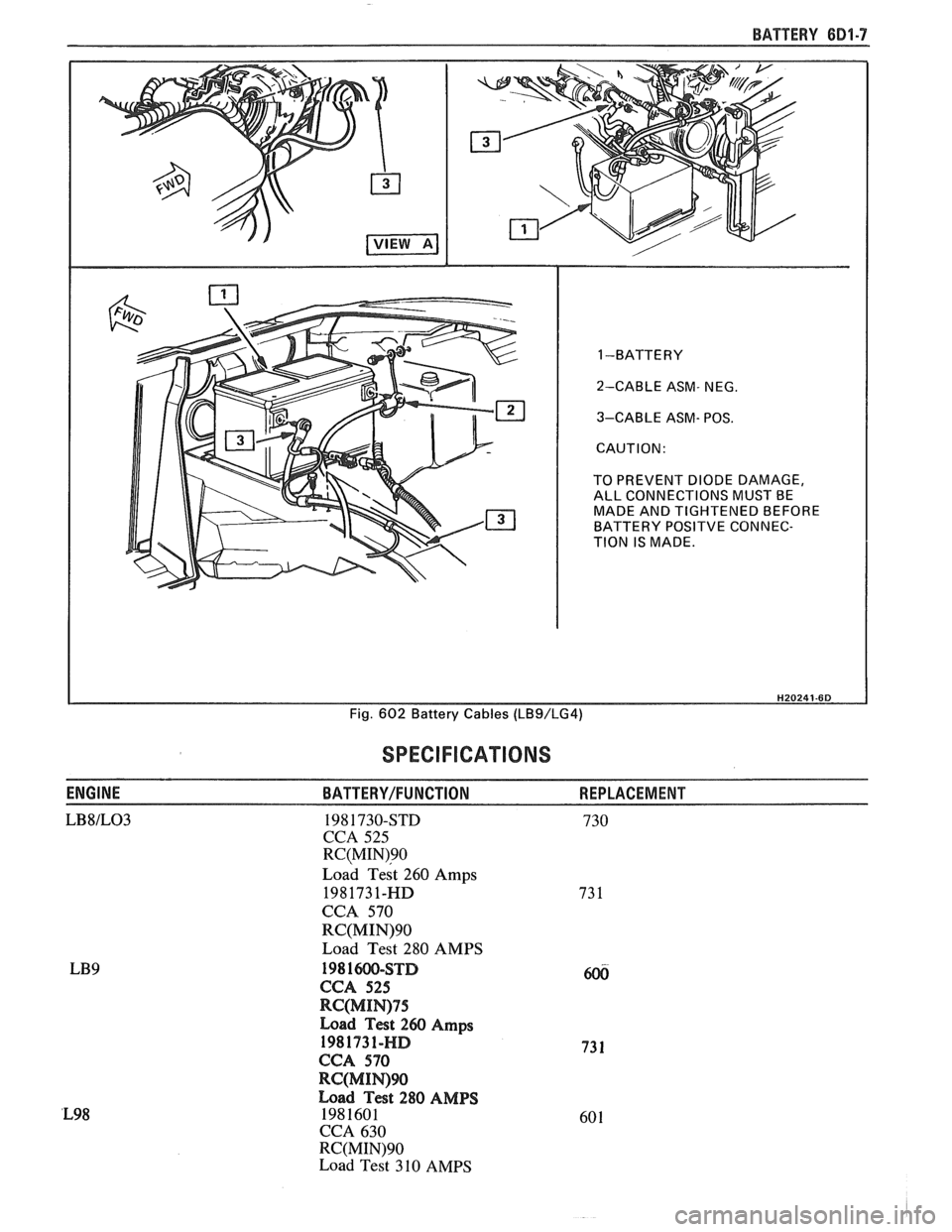
BATTERY 801-7
1 -BATTERY
2-CABLE ASM- NEG.
3-CABLE ASM- POS.
TO PREVENT DIODE DAMAGE, ALL CONNECTIONS MUST BE
MADE AND TIGHTENED BEFORE
BATTERY
POSlTVE CONNEC-
TION IS MADE.
Fig.
602 Battery Cables (LBS/LG4)
SPECIFICATIONS
ENGINE BATTERY/FUNCTION REPLACEMENT
LB8lL03 198 1730-STD 730
CCA 525
RC(MIN)90
~oad ~est 260 Amps
1981731-HD
CCA 570
RC(MIN)90
Load Test 280 AMPS
198 1W-STD
CCA 525
RC(MIN)75
Load Test 260 Amps
1981731-HD
CCA 570
RC(MIWW
Load Test 280 AMPS
1981601
CCA 630
RC(MIN)90
Load Test 310 AMPS